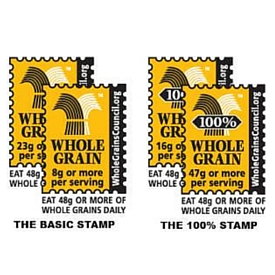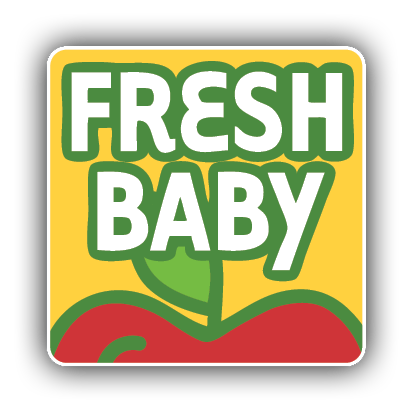
Whole grains are exactly what their name implies. The grain is left in its whole, originally harvested state. It is not cracked, crushed, rolled, or cooked down; otherwise known as processed or refined. A whole grain is more nutritious than a processed grain because the processing removes some of the nutrients. Research shows that people who regularly choose whole grains over processed grains are less prone to obesity, heart disease, stroke, cancer, and diabetes. Whole grains are a good source for fiber, magnesium, Vitamin B and Vitamin E. Making the small change from processed white bread to whole grain bread is an easy way to improve your diet.
Is it whole?
The Whole Grains Council has developed stamps to make it easier to identify whole grain products, the Basic Stamp and the 100% Stamp. The Basic Stamp is used on products that contain at least 8 grams, or a ½ serving, of whole grain. The product can also contain refined flour.
The 100% Stamp is used on products that contain at least 16 grams of whole grain per serving and all grains in the product are whole grains.
Manufacturers are not required to use the whole grain stamps on products so not all products will be easy to identify. If the product does not have the stamp, read the label.
If you see any of these words on the label, you are getting the whole grain:
- whole grain
- whole wheat
- whole
- stoneground whole
- brown rice
- oats, oatmeal (including old-fashioned oatmeal, instant oatmeal)
- wheatberries
If you see any of these words on the label, you may not be getting the whole grain:
- wheat, or wheat flour
- semolina
- durum wheat
- organic flour
- stoneground
- multigrain (may describe several whole grains or several refined grains, or a mix of both)
These words on the label mean the ingredient is not a whole grain:
- enriched flour
- degerminated (on corn meal)
- bran
- wheat germ
*Information provided by the Whole Grains Council
Whole Grains For The Family
It can be easy to add whole grains to your family meals just using a combination of whole wheat flour and white flour in some of your favorite recipes. Using oats in place of white flour is also an easy switch. Another idea is to include barley, quinoa, wild rice, wheat or rye berries, or sorghum to soups.
Using whole wheat breads, tortillas or pita for sandwiches, granola as a yogurt topping, and quinoa as a side dish instead of white rice can help make meals just as satisfying and twice as healthy. Experiment with new recipes and try a new grain once a week for a month for a twist on the same old menu.
At the market:
Varieties of Whole Grains:
- Amaranth
- Barley
- Buckwheat
- Corn, including whole cornmeal and popcorn
- Millet
- Oats, including oatmeal
- Quinoa
- Rice, both brown rice and colored rice
- Rye
- Sorghum (also called milo)
- Teff
- Triticale
- Wheat, including varieties such as spelt, emmer, farro, einkorn, Kamut®, durum and forms such as bulgur, cracked wheat and wheatberries
- Wild rice
*Information provided by the Whole Grains Council
Storage: Store in an airtight container in a cool, dry place for up to six months. Whole grains will keep up to one year in the freezer if properly packaged. Whole grain flour’s storage life is less than the intact grain. Store flour in a cool, dry place in an airtight container for up to three months.
Recipes:
Whole Grain Stuffing with Nuts, Seeds, and Fried Fruit
Creamy Tuscan Chicken Wild Rice Bisque
Grilled Cheese and Pear on Rye


